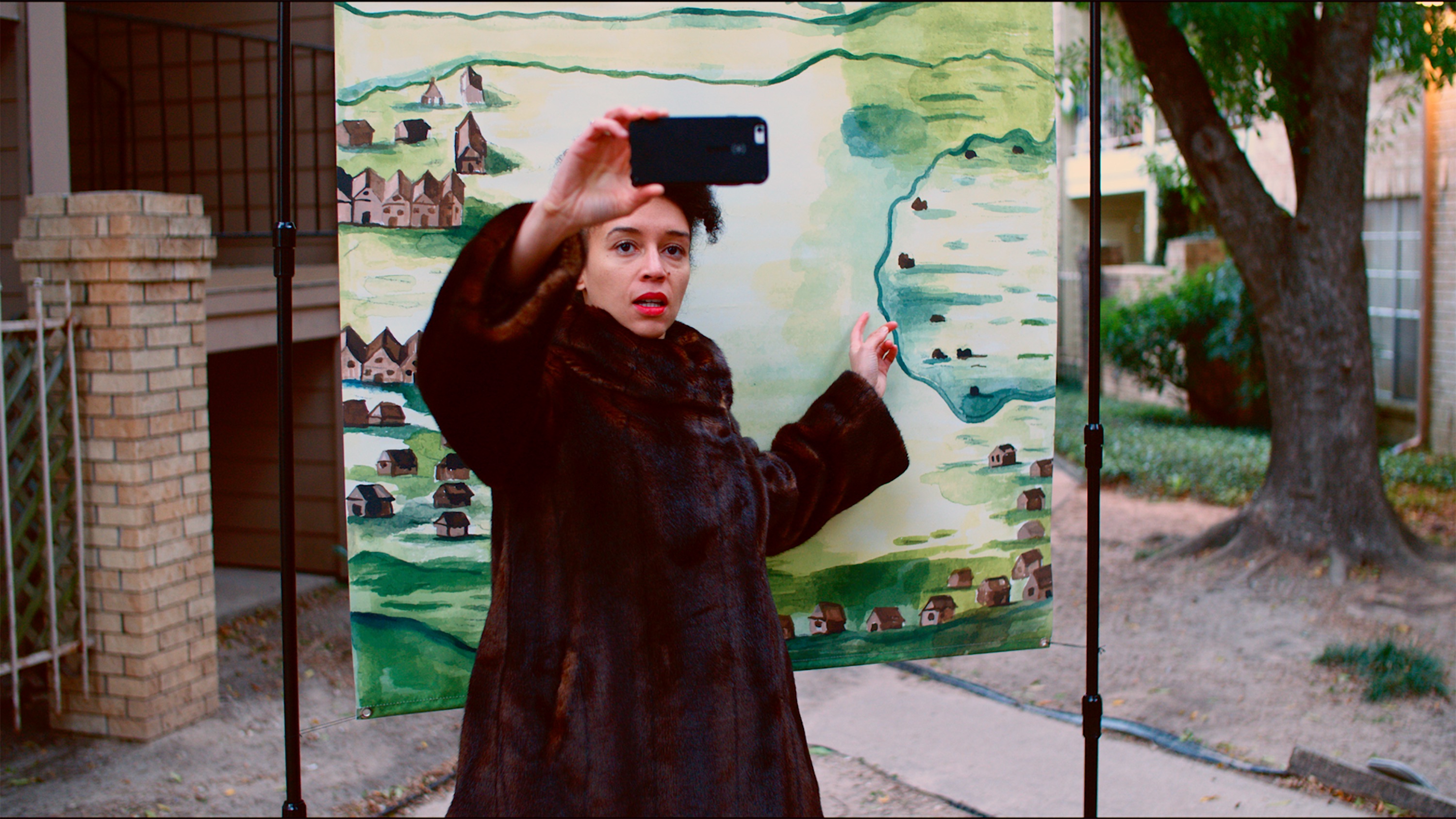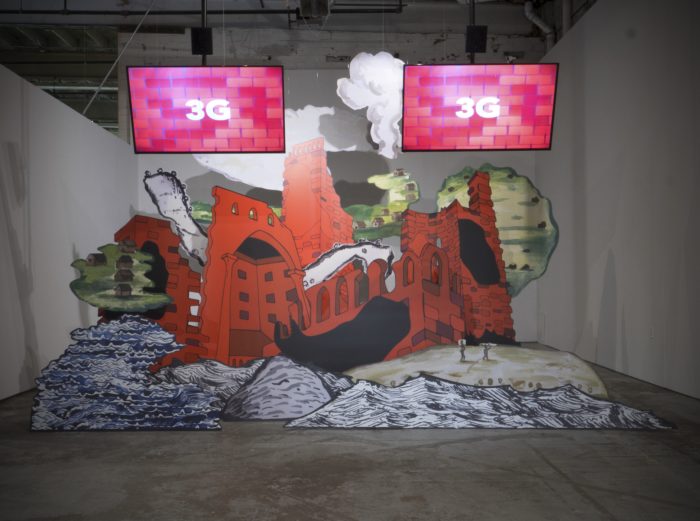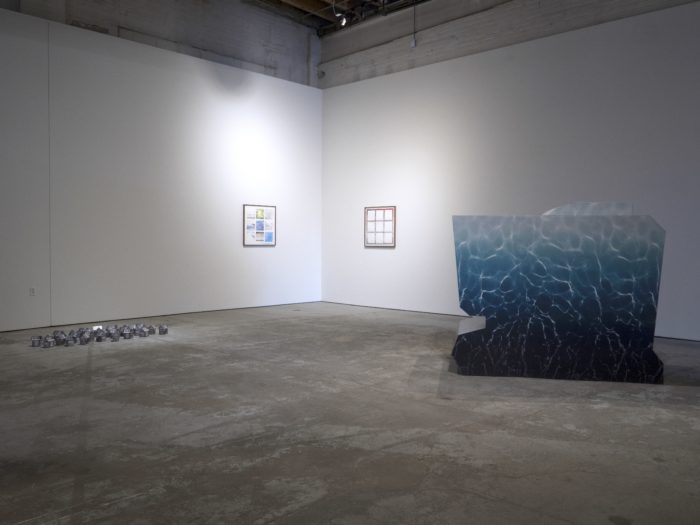
Still from Danielle Dean’s True Red Ruin (Elmina Castle), 2017. Courtesy of the artist.
“Some of the castle parts have arrived…,” says artist Danielle Dean in a foreboding voice, half-smiling as she trains her cell-phone camera at a number of bulky packages on the floor behind her. In her 2017 film True Red Ruin (Elmina Castle), which is on view as a solo presentation at MOCAD through April 15, Dean plays a conniving real estate speculator with her sights set on Cuney Homes, an affordable housing community in Houston, Texas, where the story is set. When the aforementioned “castle” appears on the lawn, now fully assembled, it’s a shock to the residents. “I just woke up this morning, and I saw a lot of red bricks outside of my window!” says the protagonist, played by Dean’s half-sister, who lives in Cuney Homes in real life. The prop castle, fabricated by Dean, evokes a children’s pop-up book illustration that has indeed popped up overnight. Its new neighbors, powerless to do otherwise, accept its existence.
For Dean, it’s less make-believe so much as it is a historical reenactment. The narrative characterizes the origins of Elmina Castle, a fortress erected in the late 15th century in Ghana by Portuguese colonizers as a gold trade outpost. Written accounts describe how ships transported pre-made castle pieces to the destination. “It’s crazy,” says Dean, as herself. “It’s this idea of bringing a design or bringing a type of building from Portugal to Ghana, and it being an original moment of a kind of imposition of design, or a type of readymade…in 1482!”
In True Red Ruin, Dean’s sister begins to entertain the prospect of working for the castle, her former skepticism giving way to cautious optimism. After the Portuguese had established Elmina Castle as a physical landmark, they cooperated with locals for as long as was necessary to ensure the success of the trading hub, which gradually became entirely co-opted for the slave trade. As True Red Ruin unfolds across Houston’s Third Ward, the power dynamics become unsettlingly familiar. The parallels to gentrification are glaring. But Dean lets viewers piece this together on their own.

Still from Danielle Dean’s True Red Ruin (Elmina Castle), 2017. Courtesy of the artist.
Tell me about your background as an artist. How did you got started, and what shaped your style and your focus? At school, it was the only thing I could do. [laughs] I grew up as an only child, and it was one of those things you could do on your own. None of my family knew what it was to be an artist, so it wasn’t like I had begun thinking that that’s what I wanted to do with my ideas of creativity. I actually thought I was going to do design. I thought that I would be better off getting a job in design than trying to be an artist. I went to Central St. Martins for the [Foundation Diploma in Art and Design] course that then led me to do joint art and design. Then I reapplied to fine art because I realized that that’s what I wanted. But then, after I graduated, I still needed to get a job.
I ended up working as a receptionist for an advertising firm on Wardour Street in Soho. Then I had a bad break up with a guy who worked on the creative floor, who was a graphics designer, and he went traveling, and I was really annoyed. [laughs] I decided to go be better than him, on his floor. So, then I went and worked as an art director on the creative floor, after doing an internship there. I worked there for a couple of years, and I think that has really influenced my work.
After that, I went to do an MFA at CalArts, and I think the relationship to thinking about the culture industry—because Cal Arts used to be associated with Walt Disney—this idea that that course has an aspect of criticality to mainstream media, I think that was good for me.
How did all this lead up to True Red Ruin? It had to do with a piece I did before, A Portrait of True Red [2016], which was about a pair of Nike sneakers called True Red: The Vampire Sneaker. The research I did led me to castles, because vampires live in castles. That’s how I ended up stumbling upon Elmina Castle. That’s why the castle piece now is called True Red Ruin, (Elmina Castle), because there is a link in my mind.

True Red Ruin, 2018, installation view. Image courtesy of the artist and MOCAD. Photo by Naaman Rosen.
There’s this predatory aspect to a vampire that resonates with colonialism in a way. If a vampire bites you, you either become a vampire or you die. That’s it. That’s what I was thinking a lot about in A Portrait of True Red, and how if you are a vampire you have to pretend to be human and what it means to mimic being human and how that kind of poses a question of what being human is. In terms of this current project, with the castle, it does become this vehicle of creating different types of subjects; it encourages a way of being in relation to this new thing, this new imposition that was built there.
Branded sneakers relate to medieval castles, in a way. I was thinking about the relationship of production to the sneakers in the sense that it basically reminded me of how Nike moved their factories to places where the labor is the most affordable; they franchise the business out to whoever is the cheapest. I thought it was interesting to think about the castle in relation to that, because it used to be a factory. The video is basically using historical accounts of the castle as a fiction in applying to the present day, and me and my sister play out that fiction in her community. Sneakers are a big deal to my sister and certain communities. So, I thought it was a way of connecting to that.
I would imagine, that with the original castle, it stood for Portugal as a new way of representing power in the area. I feel like there’s a link between the idea of seeing a brand, like the Nike swoosh everywhere, it’s another kind of— —power, yes. We have certain things that happened in the past after all that are present in different forms now.
There’s also a parallel in how the storybook quality of the physical castle you created as a prop contrasts with the clearly real-life, contemporary surroundings in the video, but within the narrative, it’s treated as this central concern. It’s an interesting layering. It was fun because, once I had the narratives together, then me, my sister, and her friends could play with it and speculate on what it would be like for those things to happen now. Part of the idea was that my sister could shoot some of it with her cell phone when I was not there. It was considering this idea that if something like that was built, you wouldn’t necessarily jump to completely not liking it—you might think that it would be cool to get a job there. So, I was interested in this complicated relationship that we have to power. It’s not simple.

True Red Ruin, 2018, installation view. Image courtesy of the artist and MOCAD. Photo by Naaman Rosen.
Stepping back, can you tell me more about how you evolved, as an artist, and before that, as an art director, to work with all these mediums in such a fluid way? How did you develop the ability or the eye to blend mediums like video and sculpture, and so on? My use of many mediums is mostly to do with the fact that I usually try to, within reason, lead with an idea. It means that sometimes I have to learn a new technique in order to do the work because it needs that knowledge.
I’m always interested in the readymade: hacking the readymade, or referencing stuff that already exists in the world, and sometimes using found footage or re-shooting certain camera angles or [other] ways of dealing with the medium that relates to how it already exists. That’s why I use a lot of different types of mediums.
One of the things is that I often start work using drawing—I’m drawing just to develop ideas, or doing storyboards, or drawing the thing, or working from the thing to copy it, to understand what it is and maybe sometimes that becomes part of the work itself. That was definitely the case with True Red Ruin, because I was drawn to the ways in which the maps, or the renderings, or the etchings, how they worked and how they displayed a type of seeing that occurred during that time, during 1482 or when the Dutch had it in [the later 1600s]. I was interested in copying those drawings, so I could understand something to do with them. Then that fed into the video itself.
I think that a lot of our visual language still relates to drawing. Like packaging has things that look like they’re hand-drawn—and they may well have been hand-drawn at the beginning and turned into a digital image. Or they’re just emulating this idea of the hand-drawn. I always was drawn to how that is still something that we’re dealing with: What’s the relationship we have to things that are created?










 in your life?
in your life?

